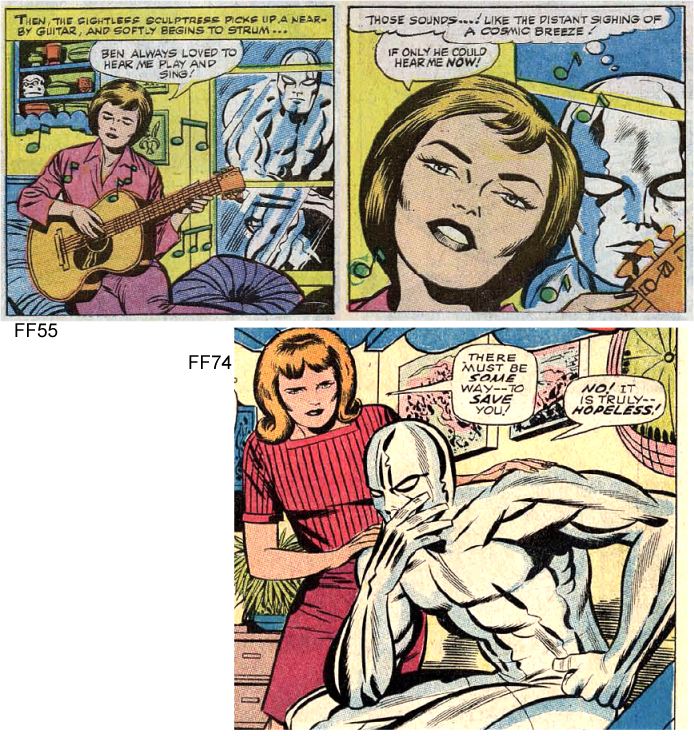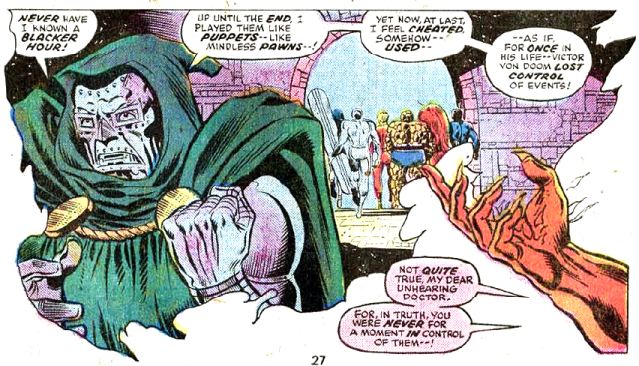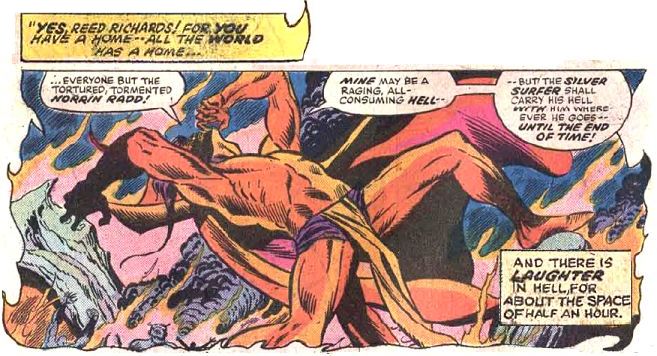







 |
 |
 |
 |
 |
 |
 |
 |
Jack Kirby's Silver Surfer and Stan Lee's Silver Surfer sound like two completely different beings: total opposites. But there is a simple explanation, and it's right there in the comics: Shalla Bal is not real. When we look closely, the Silver Surfer is a powerful story of self deception, of a man's inability to face his horrific past.


By the way, look at that image: it looks like the Surfer is on drugs.
Well he pretty
much is: the Silver Surfer issue 1 (where he "remembers" a fake life)
comes immediately after the drugs issue, Fantastic Four 76... but that's
another story. Let's stick to the basics, what we know for sure.
There are three things to know about the Surfer.
1. Galactic-scale power
First, he is
unbelievably powerful. He wields the Power Cosmic: he told Doom that if
not handled very carefully his power could destroy a galaxy.
2. The mind of a child
Second, his mind is like a child's. Until he met Alicia he had no idea
of what happened on planets, and no idea of emotion: he had to start
from nothing. Then like a child he thought that a few months observing
humans made him an expert: he began speaking shallow platitudes and making very bad decisions.

3. Love for Alicia
By awakening his spirit Alicia became a kind of mother to him, He adores
her. He wants to be near her; he comes to her when he is confused.

Now let's recall the Surfer's early history.
Fantastic Four 48-50 (the Galactus Saga)
When Alicia awakens his conscience he leaves to learn more about the Earth.
Fantastic Four 55 (the Surfer returns)
He returns, thinking he knows everything. He wants Alicia's friendship again but Ben Grimm drives him away, into the arms of...
Fantastic Four 57
...Doctor Doom, who pretends to be his friend.
Because he has the innocent mind of a child, all the Surfer wants is a friend. But Doom has a device that surrounds the Surfer's child-like mind and steals his power.

How does that work? On my web site I discuss a related technology, the sub-space portal, and how at its heart is a similar design: massively powerful electrodes either side of the head. But how could Doom create something so specialized for this purpose and do it so quickly? It took Reed years to create his sub-space portal, and he had the help of the Watcher and numerous examples of similar technology. How can Doom do this so much more quickly? A quick look at his past will answer that question. Doom is able to perform miracles of science because, when he needs a miracle, he can turn to magic.

Magic works by making deals with demons: "you do this, and I will do that." For Doom to so quickly design the perfect cosmic ray absorber he must have involved demons at some point, even if it was just in a minor incantation to ensure good luck. This means the demonic world was alerted to the Surfer's presence. Even if Doom didn't do this, how could demons not be aware of such a powerful being who brought fear and death to so many? This is important. Demons would have known about the Surfer from the start. Now let's look at the prince of demons, Mephisto.
Doom's most famous experiment was his attempt to use mechanical means
to contact the nether world, to rescue his mother from the devil. Note that this was the devil not Mephisto - the name Mephisto was not added until after we met the Surfer. But Mephisto took over this role so we shall use his name. Every
year Doom would battle Mephisto and every year Mephisto would win. This
gave Mephisto great pleasure, as Doom is such a powerful mind and such
an arrogant man. But the one person Mephisto hates more than Doom is the
Surfer. Mephisto will do everything in his power to make the Surfer suffer.

In Fantastic Four 155-157 (a historic story for many reasons that we don't need to go into here) we have the clearest picture of Mephisto's work. In the story Doom tries to claim the Surfer's power again, and Mephisto gains pleasure from denying Doom the only thing he wants: control.

We learn that Mephisto's work has many layers. Doom thought he had
found a fake Shalla Bal as bait for the Surfer. But Mephisto had put
further layers of fake memories beneath the ones added by Doom. These
fake memory layers are so subtle that the Surfer could not detect them.
The Surfer was Mephisto's main target all along.

The closer we look, the more fake Shalla Bal appears: even on face value she is the most one dimensional girlfriend ever: so sweet and perfect, yet so lacking her own will. The question must arise, what other false memories has Mephisto implanted? In the 1980s Silver Surfer issues 130-131 we learn that a great deal of what the Surfer thought about Zenn La was a false memory. How deep does this rabbit hole go? Is any of it real? Why should we think that Zenn La and Shalla Bal ever existed? They seem designed purely to cause the Surfer unhappiness.
Occam's razor
Occam's razor says we should shave off as many elements as possible from
a problem: if a question can be explained with three elements or with
two, then choose two. The simpler one is usually right. In this case
there is no need for Shalla Bal to be real. She works best if she was
always just a false memory, sometimes aided by a person with implanted
memories.. or perhaps that person was a demon all along. The dialog
between Mephisto and Shalla Bal takes on a completely new
significance if Shalla is a demon willingly controlled by her master:
she loves the Surfer in the same way that any succubus loves her victim.
The Silver Surfer's 1968 book
Zenn La and Shalla Bal first appear in the Surfer's 1968 book by Stan
Lee. In that book the Surfer is tormented and miserable. The whole book
is whining and self righteousness from start to end. In the first issue
the enticing memory appears of a place the Surfer can never have. In the second
issue he battles an enemy who does not exist (t least, not on earth -
nobody else sees them). It appears the Surfer is falling into
madness.Then in issue 3 we see Mephisto for the first time. it is
possible that Mephisto has always existed, but we have to remember the
Surfer's enormous power. Mephisto represents all the pains and fears of
death, the pains that the Surfer ignored for the thousands of years when
he led Galactus to destroy worlds. Now the Surfer has to face those
pains and fears, and cannot. So it is possible that Mephisto is the dark
side of the Surfer, split off into its own personality, just as the
Void was later the dark side of the Sentry. This is only speculation of
course.
It is fairly well known that the surfer is a Christ figure, the son of the God figure (Galactus) who sacrifices himself to save the world. Fantastic Four 72 reminds us of the religious symbolism.

The Surfer acts like he is all powerful and tries to teach the world. He tries to be like God.
Mephisto completes the picture with a Satan figure. The Biblical parallel is highlighted at the end of the Mephisto story:

The final words, "there was laughter in Hell for about the space of half an hour" is a reference to Revelation chapter 8: at the end of the world, at the opening of the seventh and final seal, "there was silence in heaven about the space of half an hour." This is just a reminder that we need to look to the Bible if we are to understand what is going on. And then we will see why Mephisto laughed so much: why his plot was so delicious to him:
Mephisto's plot was perfect because it caused the ultimate misery in the purest being, yet it was in plain view of everyone and nobody saw it! Not only did Mephisto show the Surfer the truth, that Shalla Ball was fake, but even the names he implanted in the Surfer's mind told the truth: he was telling the Surfer in plain words, and the Surfer could not see it!
The following is based on the exhaustive word studies at Abarim Publications. Remember that ancient Hebrew was written without vowels, but it was usually clear whether the vowel should be long or short. So if a short "e" changes to a short "i" and back again that is not a problem. OK, let's look at those names:
Zenn-La
In the Bible "Zin" is the famous desert south of Israel: "the wilderness
of Zin". The word comes from "sen" meaning thorn or barb. When a scape
goat was sent into the wilderness it was usually the wilderness of Zin
(or Zen). "La'a" means "to talk rashly or wildly".
So "Zenn-la" means to talk foolishly about an empty wilderness. In other words, Zenn La, the Utopia that the Surfer "remembers", does not exist.
Shalla- Bal
Shelah means either "one sent out" or "request/demand", and Baal was the
great false God. So "Shalla Bal" is the one sent by the false God.
It probably helps that "Shalla" has a similar sound to 'Lisha, the way many people pronounce Alicia. Shalla is the Surfer's idealized version of Alicia, so he really wants to believe this "memory".
Norrin Radd
"Ner" (or actually "nhr" as vowels were not written) means "lamp" or "shine". "R_n" means to be
nimble, as in "aran" for goat (mountain goats are known for being able
to go places nobody else can). When we first see the Surfer his
nimbleness defines him, and the Surfer's job was to find things, like shining a lamp into hard to find places.
So Norrin means "nimble lamp". It might be the genuine name used by
Galactus for his herald. Mephisto pronounces it as "Norrin" which is a
scientific word for a genetic disease that causes blindness.
Norrin is a lamp but he cannot see the deception that is in front of his face.
Radd, as in the Biblical name "Raddai", is from the root 'yarad'. It "is a very common verb
expressing a downward motion: to decline, descend or to go down towards
some lower location or to sink into something, etcetera." The Surfer of
course is fallen, and Mephisto wants him to fall further.
So Mephisto calls the Surfer Norrin Radd because he is fallen and is
metaphorically blind. (Alicia of course is physically blind but sees
clearly, so Mephisto stays away from her.)
Mephisto
Mephisto is short for Mephistopheles: from "mephitz" ("destroyer") and
"tophel" ("liar"). Tophel is short for tophel sheqer, literally
"falsehood plasterer" (Job 13:4). (Source: Etymology Online)
So Mephisto means "destroyer who hides the truth".
To conclude: Shalla Bal and Zenn La probably never existed. They are implanted memories designed to torment the Surfer, supported as needed by demons or an actual desert planet in disguise.
The Surfer has led
Galactus to kill billions of people, and he will grasp at any straw to
believe he is somehow innocent. It is the only way he can live with himself.
So the Surfer is on the edge of godhood and the edge of madness. He surfs the extremes in every meaning of the phrase.